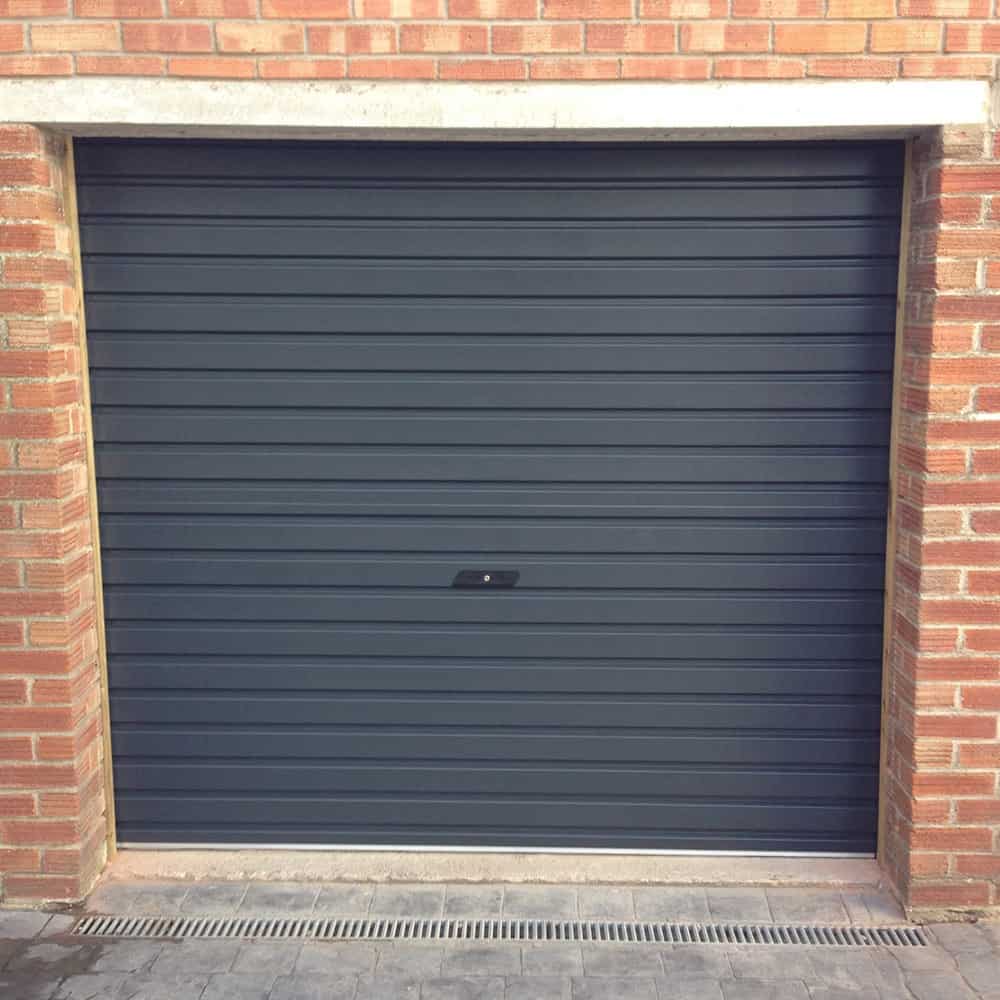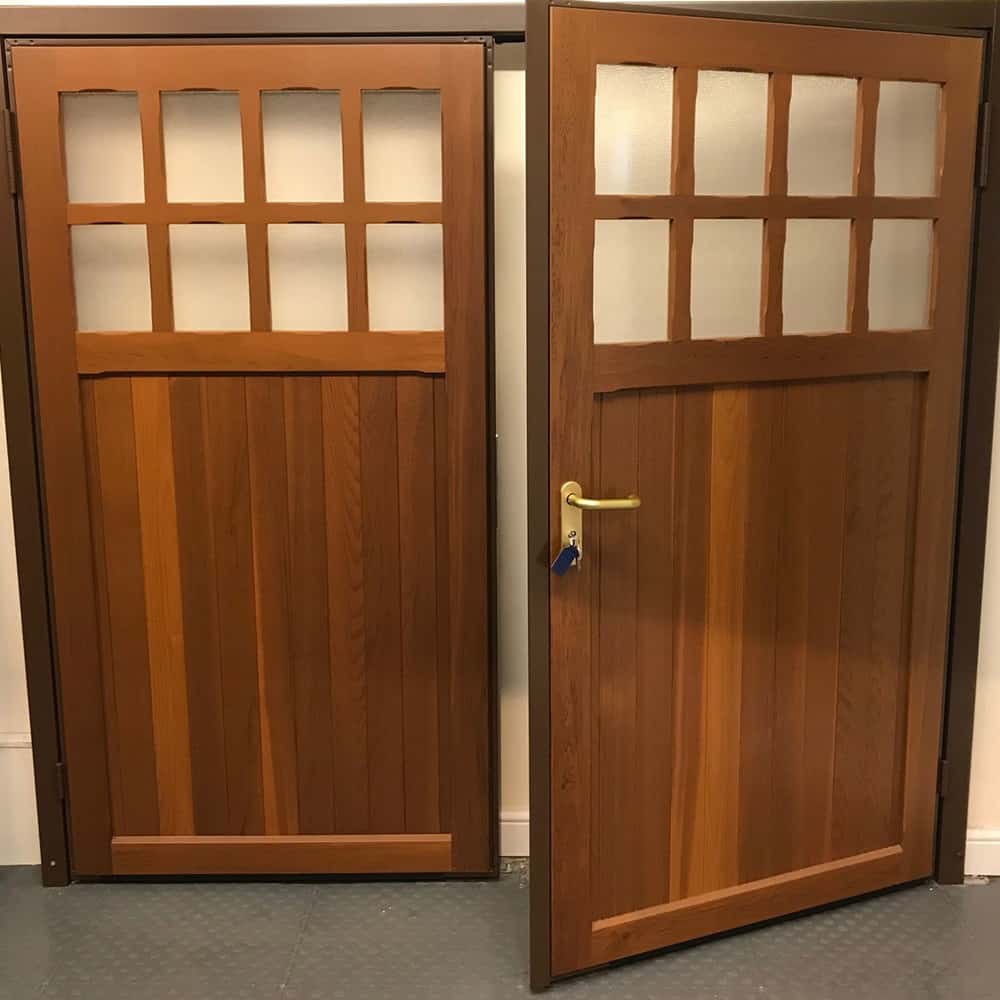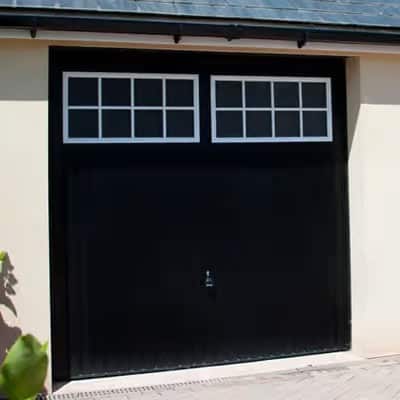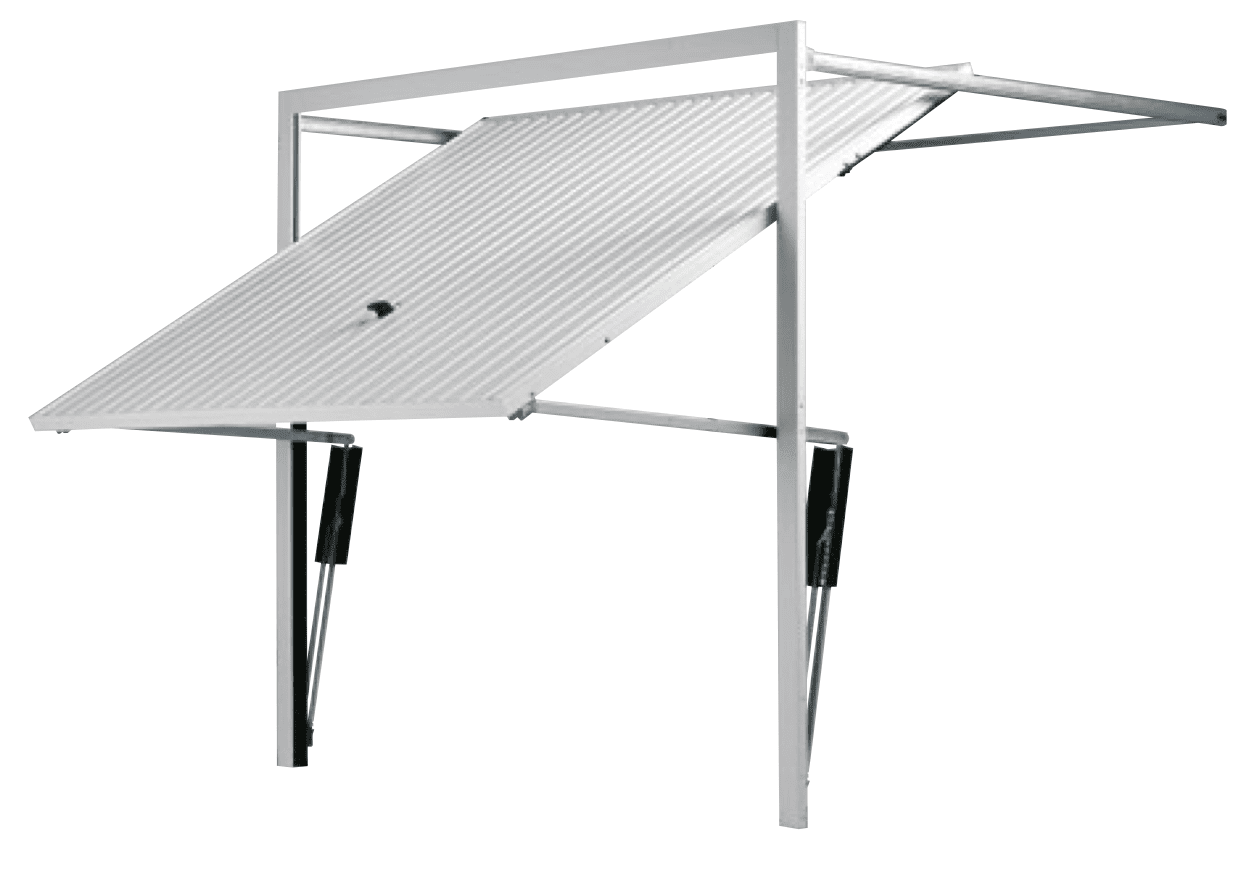Information About Specific Types of Garage Doors
- Home
- /
- Garage Doors Information Centre
- /
- Information About Specific Types...
Topics in this section include information specific to individual door types such as quality differences, safety features and other functionalities.
Roller Garage Doors

Unlike other types of garage doors such as up and over doors, sectional doors and side-hinged doors which require large capital costs to set up such businesses there has emerged a cottage industry around the manufacture of very basic roller garage doors masquerading as quality doors.
Often made with no regard to government legislation around safety and with the cheapest possible materials these doors may appear visually similar to quality roller garage doors – and are marketed with attractive images which frequently aren’t actually the door that is being sold – but despite their often very cheap prices they do not represent good value.
When choosing a roller garage door there are a number of factors to look out for:
- Guarantee periods – A 5 year guarantee should be standard on a good quality roller door. If you have to pay for a guarantee, or a guarantee extension, then query why this is. If this guarantee is then offered by a company with a different name to the supplier be extra wary.
- Safety Features – Government legislation mandates that all remote controlled, powered doors have to have a safety edge in the leading edge, or other equivalent safety device, to stop the door if it encounters an obstacle. All quality roller doors will have such a device. If the door does not, most often being labelled as ‘hold to run’, then it is not compliant and this door will not provide a safe solution for you or your family and if it does encounter an obstacle the door will not stop causing damage to the door and, potentially, to people. On occasion low quality suppliers will offer a safety edge or equivalent as an option – safety should not be optional.
- Thickness of Door Slats – Roller garage door curtains (the curtain is the part of the door that moves up and down in the guides to secure the garage) are made up of a series of interlocking slats. On quality roller garage doors there are often two profiles offered – 77mm and 55mm. These slats, if fit for purpose as a garage door, should be at least 16mm and 9mm thick respectively. The doors we use are so strong that they achieve the Police Approved ‘Secure By Design’ accreditation in the 77mm profile. To cut costs many low quality roller garage door suppliers are offered with slats as narrow as 44mm and 5mm thick, and 55mm slats that are 6mm thick are touted as the high quality option. Doors with 44mm and thin 55mm slats are designed for window shading, not as garage doors, and as many online videos will testify can easily be pushed through, enabling entry to the garage in under 5 seconds.
- Roll Covers – Good quality roller garage doors should be supplied with a full enclosure which covers the roll of the door. This both looks neat, protects the door from knocks, minimises dust and debris entry and most crucially it dramatically decreases the risk of accidental entrapment. Low quality roller garage doors very often do not have such a cover, or if they do they are offered as an optional extra – again, safety should not be optional.
One of our preferred suppliers, AluRoll, have prepared there own comparison sheet which is available below:
As with many things in life, the old adage ‘buy cheap, buy twice’ definitely applies to low quality roller garage doors.
For more information on our range of roller doors follow this link: www.upandoverdoorsltd.co.uk/rollerdoors
Automated roller garage doors are typically fitted with one of two devices to power the safety edge system – either a wired system or a wireless one. The safety edge is the part of a roller door which is in the leading edge and means that the door will stop if it encounters an obstacle.
Wired systems are easy to identify as they will have a curly cable (think 1980’s phone cable) running from the safety edge transmitter on the bottom edge of the door to the control unit. This provides direct power and gives the benefit of meaning that you will never have to change a battery as you would on a wireless system. The issue with wired safety edges is that the cable itself is fairly unsightly and also that in a typical garage full of stuff it is quite common for the cable to become snagged on an immovable object and as the door moves it is not unknown for the cable to be pulled out of the safety edge transmitter or the control unit. Whilst this is relatively simple to repair this will incur some cost to repair as it wouldn’t be considered a warranty issue and cause the door to stop functioning until fixed.
As such, wireless systems are very much more popular due to the aesthetic benefit of not having a large cable running between the door and the control unit and removing the associated risk of the cable being damaged. The negative of a wireless system is that in stead of direct power, they are powered by a battery which will need periodic replacement.
There are three main types of safety edge available which are designed to detect if your roller garage door has hit an obstacle. Each has their own benefits and their suitability is largely dependent on the conditions of your garage and on how level your garage floor is.
The three main types are:
Optical Safety Edge: Perhaps the most popular type of safety edge is the optical edge. This consists of a photo beam (essentially a beam of light) that passes through the rubber bottom edge of the door. If the door encounters an obstacle it will squeeze the rubber, breaking the beam and causing the door to stop and reverse. These are robust and reliable systems which have a lower power requirement. However, If your floor is not level, and particularly if it rises to a peak in the middle of floor, then this can push on the rubber edge and over time can deform the rubber. In extreme cases this can mean that the optical beam is constantly blocked which will require a replacement safety edge.
Electrical Safety Edge: Very similar to the optical safety edge, this consists of a pair of wires that run through the rubber bottom edge of the door. Again, if the door encounters an obstacle this squeezes the rubber, pushing the two wires together and when they touch it causes the door to stop and reverse. The slight negative with this type of edge is that they can be slightly more susceptible to water ingress which can degrade the wires. However, they are the lowest option so on wireless systems the battery will last a little longer. Like the optical edge, if your floor is not level, and particularly if it rises to a peak in the middle of floor, then this can push on the rubber edge and over time can deform the rubber. In extreme cases this can mean that the optical beam is constantly blocked which will require a replacement safety edge.
Vibration Safety Edge: The newest type of safety edge works in a different way to the optical and safety edge. With these systems the rubber seal in the leading edge is just for weatherproofing and the vibration detection system is located in the middle of the bottom slat of the door. This works to detect the vibrations that are caused by impact and will cause the door to stop and reverse. Extensively tested to not react to the normal levels of vibration caused simply by the door operating, this system is state of the art. They are particularly helpful where the floor is not level or rises to a peak as whilst this may have an impact on the bottom rubber seal, it does not affect the device itself. The only known negative of this type of system is that if the door is operating in very high winds it can be possible that the edge will interpret this vibration as an obstacle and shut the door. Again, the doors are tested to take wind into account so it is only in very extreme conditions that this might be an issue.
There are other roller door systems (Garador / Hormann rollers) which don’t use a safety edge system but instead use an amperage monitoring system to make the door safe – if the door encounters an obstacle the power level will spike and this will be instantly monitored by the motor, causing the door to stop and reverse.
We have doors in our showroom with all the different safety systems attached so you can test them and see how they work for yourself
If you are offered a door without a safety edge system or any other form of system that stops the door when it hits an obstacle then beware – this is non-compliant and is usually only the case as a cost-cutting measure on cheap roller garage doors.
For more information and help specifying the right system get in touch today.
If you are in any doubt as to whether or not your roller garage door has safety features then as a starting point exercise extra care when using the door as generally if you aren’t sure, it probably doesn’t. This is particularly true on cheap and / or budget roller doors installed at ‘too good to be true’ prices.
The best way to identify if your roller door has safety features is to take a look at the leading edge of the door – the part that closes against the garage floor. Nearly all roller doors have a rubber seal in the leading edge but if the seal is a narrow strip or is solid then it is likely just for weatherproofing and is not a safety edge. If the seal is larger and appears to have a number of chambers then it may well be a safety edge.
To physically test if there is a safety system then you can take an item such as an empty cardboard box and put it in the middle of the garage opening and let the door close on to it. A cardboard box is a good option as it should be stiff enough that it should offer enough resistance so that the door will stop when it touches it but equally if the door does not stop then it is unlikely to damage the door. Please be aware that this is not always the case and you should use your own discretion to decide if this is an appropriate course of action for you and your door. If the door stops, and ideally reverses, then good news, you appear to have a safety edge system. If it does not stop and crushes the box then exercise strong caution.
We cannot legally work on a door without an appropriate safety edge system but if you want to we can install a new safety edge system to your door which includes a new control unit and remote controls. However, it is worth doing a cost-benefit analysis as this work is often over half of the cost of a whole new door system.
The simplest option to identify whether you have a compliant roller garage door is to take a photo of the inside of your door and send it to us. We will then be able to let you know what sort of door you have and what can be done for it.
We can carry out repairs, and source the parts to repair if you want to attempt a DIY repair, for virtually any door, including a whole range of roller garage doors.
The most typical parts that require repair are locks, lock barrels, the straps that attach the door curtains to the shafts that lift the doors and motor repairs.
To identify what sort of garage doors you have or for more information about the availability of repairs get in touch today.
Please note that if you have a motorised roller garage door that does not have any safety features then it is not compliant with minimum safety standards and as such we cannot repair it. We can though update it to have a safety edge system which is a device in the leading edge of the door which detects if the door has encountered an obstacle and will cause the door to stop and reverse if it hits something. This also includes 2 new remote controls, a new control unit, new bottom rubber seal and which then means that your door is safe going forwards and we can repair any other issues it might have.
Yes you can! In fact they are one of the most popular door options.
Non-insulated roller garage doors are a very popular option on simpler garages where enhanced weatherproofing and vertical opening is desired, but insulation is not essential.
With a rubber strip in the leading edge of the door which forms a compression seal to the floor and a C profile track which means that there are no gaps around the door then bad weather is kept outside. Coupled with an extremely robust plastisol surface finish in a range of colours as standard and with 2 point steel locking bolts in the middle of the door they are a great option.
The doors are typically manual, with a counterbalance spring mechanism to make lifting the door effortless, but they can also be motorised either at the time of installation or at a later date.
For more information get in touch today or visit our roller door page where we have more information and brochures available.
Whilst roller garage doors are most typically motorised they can be had in a manual specification for the convenience of vertical opening and enhanced weatherproofing but with the simplicity of manual operation.
The most popular manual roller garage door is the single skin steel roller doors which are counterbalanced by a spring mechanism. For more in depth information about these doors please read our article ‘Can I have a non-insulated roller door?’. These doors can be automated at a later date if desired.
Less commonly the insulated type of roller door can be manually operated with the motor system replaced with a counterbalance spring system similar to that used on the single-skin roller garage doors. The main difference is that the locking system is located in the bottom edge of the garage door which is less convenient than the locking on the single skin steel roller doors which is located in the middle of the door – the challenge is that to lock and unlock the door you need to kneel or bend to the bottom of the door which isn’t wildly convenient, and less so still in unpleasant weather. However, where you want an insulated, vertical opening door and don’t have power available, they are the best option.
For more information please get in touch and we will be pleased to assist.
Sectional Garage Doors

Yes, you can!
Whilst the vast majority of sectional garage doors are motorised, they can be easily used manually with the addition of a manufacturers manual locking kit. As all sectional doors are balanced by a spring mechanism then, as long as the door is properly balanced, opening and closing the door is effortless.
Sectional garage doors do not come with a manual locking kit or handle as standard so they do need to be specified rather than being included, and there is a cost for the manual handle kit. When balanced against the cost of having the door motorised instead then there isn’t a huge difference, which is why most doors aren’t manual.
However, in scenarios where you just don’t want a motor or if you don’t have power in your garage then a manual sectional garage door can be a good option.
As the locking mechanism engages into the side frame of the door then the handle is almost always dressed to one side of the door – you can specify left or right, whichever suits best.
If you do have a manual sectional garage door and then later on decide that actually having the door motorised would suit better then this is still possible. In situations where there is no power in the garage then it is possible to get a battery powered motor – for more information on this please visit our article ‘Can I motorise my garage door if there isn’t power in my garage?‘
For more information about manual sectional garage doors or if you have any other queries get in touch today.
Side-Hinged Garage Doors

When you use your garage door as a utility space then it can be helpful to have the option to only open a small part of the garage opening when coming and going the majority of the time. In this way you don’t need to expose the whole of the inside of the garage to the weather, but the opening is still wide enough to easily allow pedestrians, bikes and lawn mowers.
As such, all the side hinged garage doors that we offer have the option to be supplied in a 1:3 / 2:3 split, as well as the more conventional 50:50 arrangement. In addition the doors can either have the left hand or right hand as the leading leaf to suit how you use your space.
Whatever your requirement, get in touch today and we will be pleased to help.
Up & Over Garage Doors

Canopy and retractable garage door gear refers to the mechanisms that operate up and over garage doors.
Whichever gear you choose then the fundamentals are the same – the use of a spring system to counterbalance the weight of the door, the handle, the door panel itself, the locking, the construction and the use of a steel frame.
However, in this article we will go through the main differences.
Canopy door gear is the most widely used and is typically used on manual garage doors. The main benefit is that the tracks run up the back of the door frame rather than projecting into the garage space so that when the door is shut it sits completely flush. As the name suggests, when the door is open a third of the door projects out of the garage opening, forming a canopy. The rest of the door sits inside the garage, projecting back into the garage 1240mm.
The spring mechanism of the door is a continuous torsion spring which runs along the top of the door frame and links to the cables that lift the door panel.
The canopy doors have a 55mm wide steel frame – the narrowest frame available on any garage door and are available in sizes of up to 8’ / 2438mm wide. Over this width then the doors have to have retractable gear as it is better suited to supporting the increased weight of larger garage doors.
By contrast with the canopy gear, retractable doors have tracks that permanently project back into the garage – the tracks are always 40mm shorter than the door is tall. So a 7’0 / 2134mm door has tracks that are 6’10 / 2094mm. When the door opens the panel fully retracts into the garage with no external overhang.
The spring mechanism on modern retractable doors takes the form of a cluster of springs – 3 either side on single doors, 6 on double doors – which enable the doors to be easily operated manually. One of the main reasons for choosing a retractable door is that they are suitable for motorisation. You can motorise a canopy type garage door but you need to add a special bow arm device to the door to enable this.
The garage door frame on retractable doors is 75mm wide, a little wider than the canopy door frame, and rather than the door being lifted by cables it is lifted by metal link arms which attach to the frame.
For maximum longevity the retractable up and over garage door is more or less unbeatable but the trade off is that the link arms that lift the door can narrow the door opening a little either side, whereas the canopy mechanism ensures that the drive-through opening is completely clear. To overcome this then there is the option for Retractable Plus gear which means that the height that the link arms narrow the opening is designed to be above wing mirror height of most vehicles.
Please see the images below of the two types of door gear:
Canopy and retractable garage door gear refers to the mechanisms that operate up and over garage doors.
Whichever gear you choose then the fundamentals are the same – the use of a spring system to counterbalance the weight of the door, the handle, the door panel itself, the locking, the construction and the use of a steel frame.
However, in this article we will go through the main differences.
Canopy door gear is the most widely used and is typically used on manual garage doors. The main benefit is that the tracks run up the back of the door frame rather than projecting into the garage space so that when the door is shut it sits completely flush. As the name suggests, when the door is open a third of the door projects out of the garage opening, forming a canopy. The rest of the door sits inside the garage, projecting back into the garage 1240mm.
The spring mechanism of the door is a continuous torsion spring which runs along the top of the door frame and links to the cables that lift the door panel.
The canopy doors have a 55mm wide steel frame – the narrowest frame available on any garage door and are available in sizes of up to 8’ / 2438mm wide. Over this width then the doors have to have retractable gear as it is better suited to supporting the increased weight of larger doors.
By contrast with the canopy gear, retractable doors have tracks that permanently project back into the garage – the tracks are always 40mm shorter than the door is tall. So a 7’0 / 2134mm door has tracks that are 6’10 / 2094mm. When the door opens the panel fully retracts into the garage with no external overhang.
The spring mechanism on modern retractable doors takes the form of a cluster of springs – 3 either side on single doors, 6 on double doors – which enable the doors to be easily operated manually. One of the main reasons for choosing a retractable door is that they are suitable for motorisation. You can motorise a canopy type garage door but you need to add a special bow arm device to the door to enable this.
The garage door frame on retractable doors is 75mm wide, a little wider than the canopy door frame, and rather than the door being lifted by cables it is lifted by metal link arms which attach to the frame.
For maximum longevity the retractable up and over garage door is more or less unbeatable but the trade off is that the link arms that lift the door can narrow the door opening a little either side, whereas the canopy mechanism ensures that the drive-through opening is completely clear. To overcome this then there is the option for Retractable Plus gear which means that the height that the link arms narrow the opening is designed to be above wing mirror height of most vehicles.
Please see the images below of the two types of door gear:

Canopy

Retractable
Whatever it is that you need, we would be really pleased to discuss your needs and help find the solution for you so get in touch today.
Interested in our offers and promotions? Then please sign up to our newsletter and be part of our growing community.


